Newport News, Va. – A project led by the U.S. Department of Energy's Thomas Jefferson National Accelerator Facility's Theory Center has been allotted 10 million hours of processing time by DOE's 2007 INCITE program on the Cray XT3 located at Oak Ridge National Laboratory.
According to Jefferson Lab Theory Center member and the project's Principal Investigator, Robert Edwards, researchers will use the time to calculate the properties of subatomic particles – from the familiar protons and neutrons in everyday matter to the pi-mesons found in cosmic rays.
Specifically, researchers aim to more precisely predict the particles' behavior in experiments with powerful particle accelerators. For instance, one goal is to provide better theory predictions for research to be performed with Jefferson Lab's accelerator following its upgrade, now in the engineering and design stage. The 12 GeV Upgrade will double the energy of the Jefferson Lab accelerator's electron beam and upgrade the scientific capability of four experimental halls.
Edwards and his group will use the supercomputer time to help them run a simulation of a very important experiment planned for Jefferson Lab's upgraded capabilities. The experiment will shed light on the force that forms subatomic particles by producing so-called hybrid mesons.
Robert Edwards is a member of Jefferson Lab's Theory Center and the project’s Principal Investigator.
“What is important about this [research] is that this basically tells you the rate at which you can produce hybrids,” Edwards explains, which validates the degree of accuracy of the proposed experiment. “We could not do these calculations for the 12 GeV Upgrade project without a supercomputer.”
The time was awarded as part of the 2007 Innovative and Novel Computational Impact on Theory and Experiment (INCITE) program. The program awarded 45 projects a total of 95 million hours of computing time on some of the world's most powerful supercomputers. DOE's Under Secretary for Science Dr. Raymond Orbach presented the awards at the Council on Competitiveness in Washington, D.C. on January 8.
“That we were selected to get the highest amount of time indicated that the science is very compelling and that the Lab's mission is very compelling,” Edwards says.
The project was submitted under the auspices of the United States Lattice Gauge Theory Computational Program (USQCD), a consortium of top lattice quantum chromodynamics (LQCD) theorists in the United States that spans both high-energy physics and nuclear physics. In addition to Edwards, three other USQCD members are part of the research team: Robert Sugar, University of California, Santa Barbara; Martin Savage, University of Washington; and David Richards, Thomas Jefferson National Accelerator Facility. USQCD rigorously reviewed the scientific merit of the project prior to its submittal.
For more information:



